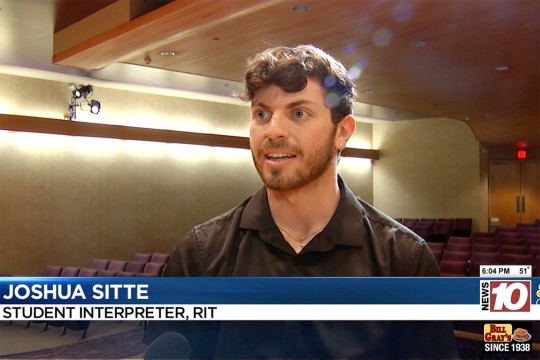RIT International Studies Professor Earns Fellowship to Continue Child Slavery Research
Benjamin N. Lawrance follows case of six children once enslaved on the Amistad
Elizabeth Lamark/ETC Photo
Benjamin N. Lawrance
The 1997 Steven Spielberg film Amistad was based on the 19th-century story of 56 African captives sold as slaves and illegally transported aboard the Spanish ship bound for Cuba. The captives took control of the ship and were arrested and tried in Connecticut after they were detained by the United States military. In 1841, the Amistad case reached the U.S. Supreme Court, which ruled in favor of the captives who were sold illegally based on U.S laws. The slaves, including several children, were set free and allowed to return to Africa.
Today, UNICEF officials estimate that child trafficking affects at least 200,00 children each year. Benjamin N. Lawrance, the Barber B. Conable Jr. Endowed Chair in International Studies at Rochester Institute of Technology, has earned a faculty fellowship from the National Endowment for the Humanities that will allow him to continue his 19th-century child slavery research with a trip to Sierra Leone in April and complete his book, Amistad’s Orphans.
“Amistad’s Orphans examines the experience of African child slaves during the 19th century as slavery became increasingly illegal in both the Atlantic world and continental Africa,” says Lawrance. “I use the life histories of six children who traveled in different capacities and different routes as segues to thematic chapters exploring important topics in illegal child enslavement. Each child had a unique experience of enslavement and inhabited multiple slave systems and their stories take us on a journey from West Africa to Cuba, the United States, Canada and back to West Africa. Their collective stories provide a framework for understanding the historical context in which children were pawned, kidnapped, enslaved, re-enslaved, rescued and freed.”
In his research, Lawrance explains that child-slave identities are qualitatively different to adult slave identities. According to Lawrance, children crafted child-specific survival strategies to sustain themselves through the painful experience of enslavement—an important contribution to scholarly understandings of childhood, enslavement, and slavery systems in the 19th and 20th centuries.
Lawrance has studied childhood slavery in a variety of cultures including ancient Greek and Roman history. In graduate school, he studied how slavery re-invents itself and how professional slave traders evaded laws, regulations and controls. He has previously completed five books, including the co-edited Trafficking in Slavery’s Wake (Ohio University Press, 2012), a cross-disciplinary anthology of essays by leading scholars and activists researching trafficking of women and children, and Local Foods Meet Global Foodways: Tasting History (Routledge, 2012), with Carolyn de la Peña from University of California-Davis.















